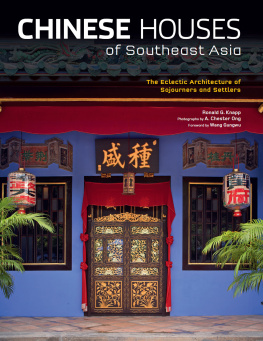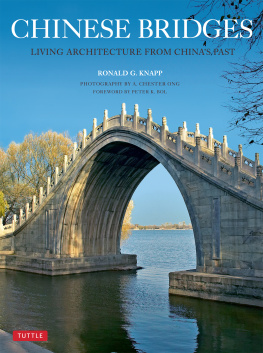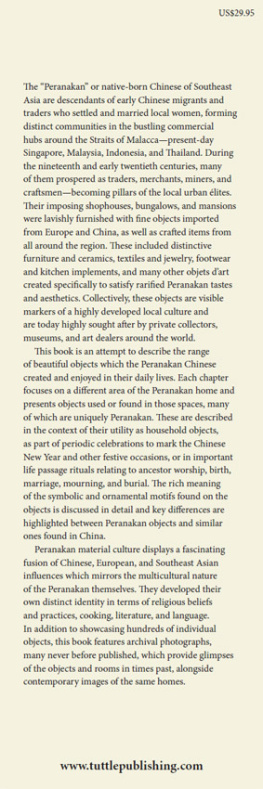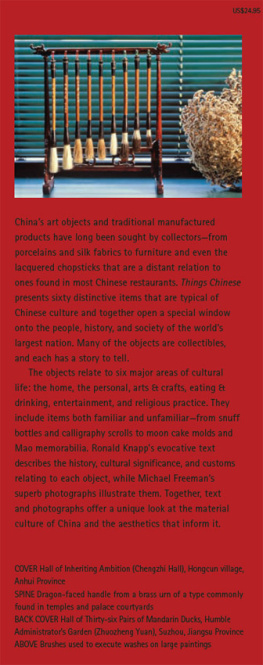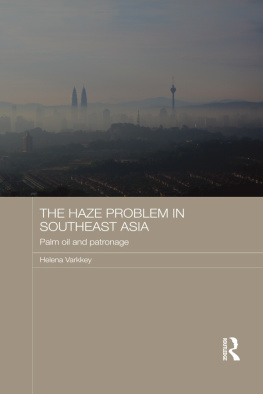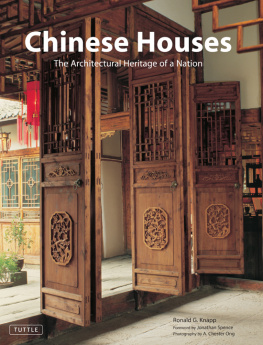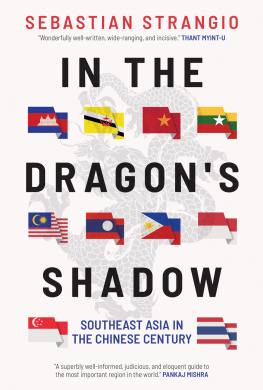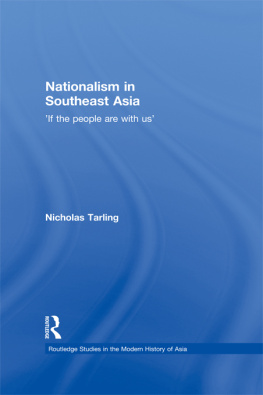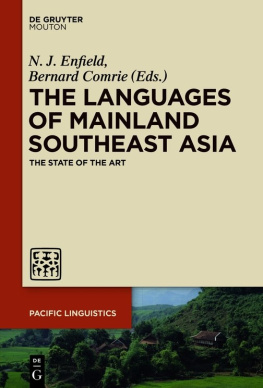Ronald G. Knapp - Chinese Houses of Southeast Asia
Here you can read online Ronald G. Knapp - Chinese Houses of Southeast Asia full text of the book (entire story) in english for free. Download pdf and epub, get meaning, cover and reviews about this ebook. publisher: Tuttle Publishing, genre: Home and family. Description of the work, (preface) as well as reviews are available. Best literature library LitArk.com created for fans of good reading and offers a wide selection of genres:
Romance novel
Science fiction
Adventure
Detective
Science
History
Home and family
Prose
Art
Politics
Computer
Non-fiction
Religion
Business
Children
Humor
Choose a favorite category and find really read worthwhile books. Enjoy immersion in the world of imagination, feel the emotions of the characters or learn something new for yourself, make an fascinating discovery.
- Book:Chinese Houses of Southeast Asia
- Author:
- Publisher:Tuttle Publishing
- Genre:
- Rating:5 / 5
- Favourites:Add to favourites
- Your mark:
- 100
- 1
- 2
- 3
- 4
- 5
Chinese Houses of Southeast Asia: summary, description and annotation
We offer to read an annotation, description, summary or preface (depends on what the author of the book "Chinese Houses of Southeast Asia" wrote himself). If you haven't found the necessary information about the book — write in the comments, we will try to find it.
Chinese Houses of Southeast Asia — read online for free the complete book (whole text) full work
Below is the text of the book, divided by pages. System saving the place of the last page read, allows you to conveniently read the book "Chinese Houses of Southeast Asia" online for free, without having to search again every time where you left off. Put a bookmark, and you can go to the page where you finished reading at any time.
Font size:
Interval:
Bookmark:
ACKNOWLEDGMENTS
While reviewing the illustrations and text for Chinese Houses: The Architectural Heritage of a Nation (2005), Eric Oey, the Periplus/Tuttle publisher, asked whether I would consider doing field work and research for a book on Chinese houses in Southeast Asia. I was intrigued by the idea, having actually never thought of Chinese houses outside of China, yet my initial reaction was one of skepticism that such a book was possible, questioning first whether indeed there were old Chinese-style homes still standing and, secondly, how I would find and get access to those that could be located.
Forty years of experiences in China and Taiwan had provided me with a range of knowledge and sufficient confidence that made it possible to carry out relatively unfettered rural field work there. Even as I was finishing up Chinese Bridges: Living Architecture from Chinas Past (2008), other research topics in China continued to beckon. Still, the prospect of taking a detour and commencing a fresh China-related research agenda outside the boundaries of China proved quite attractive, even as significant challenges seemed likely.
I had lived in Singapore for more than a year in the early 1970s and traveled throughout Malaysia and Thailand, yet I had no recollection of seeing any Chinese-style residences except for the ubiquitous and often nondescript shophouses. While I recalled reading that some immigrants had built Chinese-style homes in Southeast Asia, in truth I had little sense of what forms they might have taken. Preliminary archival research turned up photographs taken in the early twentieth century of what indeed were residences in Southeast Asia like those traditionally built in southern China. The issue, however, was whether any were still standing at the beginning of the twenty-first century.
After further discussions with Eric Oey in the summer of 2007, who promised to assist in making some initial contacts, I agreed to take on what I knew would be a demanding project with increasing optimism that the effort would not be totally fruitless. Indeed, just contemplating the search for elusive old Chinese homes, whether derelict or renovated, was exhilarating, and I increasingly looked forward to this quest.
Chester Ong, the masterful photographer who collaborated with me on both Chinese Houses and Chinese Bridges , and I decided to begin the project in fall 2007 by first revisiting Guangdong and Fujian, which had been the home provinces of most Chinese emigrants to Southeast Asia. Not only did we want to better understand the regional characteristics of homes in these two provinces, but we also wanted to visit residences build by Returned Overseas Chinese, those who had been successful in the Nanyang and returned to their home villages. This initial foray was followed by three separate lengthy trips in 2008 to Singapore, Malaysia, Indonesia, Thailand, and the Philippines in search of old Chinese houses. In late Fall 2009, we returned to the remote mountainous areas of Guangdong province to photograph the planned retirement homes of Cheong Fatt Tze (Zhang Bishi) of Penang and Tjong A Fie of Medan.
Early on, we projected finding and documenting approximately twenty old residences, but in time we visited and photographed nearly four times as many that were built between the late eighteenth and early twentieth century. Nearly forty of these are featured in this book, with glimpses of most of the others as well. Some of the homes have a distinctive patrimony in that they are linked to historical figures, but the origins of some are only sketchy. It has been enlightening to reconstruct the nature of past social, economic, and geographic conditions, and link them to family histories, which I see as one of the major contributions of this book. Because the materials collected far exceed what can be presented in this book, which is structured around individual residences, a companion volume will be published in 2011. This second book will be structured topically in order to focus on the full range of material objects enjoyed by Peranakan Chinese families within their architectural spaces or settingsthe roomsof their terrace houses, bungalows, and mansions during the late nineteenth and early twentieth centuries. These objects will provide opportunities to discuss the symbolic meaning of recurring motifs and the use of the objects in daily life and periodic life passages, subjects only explored tangentially in Chinese Houses of Southeast Asia .
A book of this scope could not have been written without the generous support of countless individuals throughout Southeast Asia. Critical initial contacts were facilitated by the Periplus team: Eric Oey and his wife Christina Ong in Singapore and Malaysia as well as Judo Suwidji and Joko Santoso in Indonesia. Others in the Periplus family were also incredibly helpful: Noor Azlina Yunus who made some key contacts in Malaysia, as well as Tessa Bombong and Yohana Cai who made arrangements throughout Indonesia and quickly did some necessary translations for us. We owe special gratitude to Anton Ong who traveled with us throughout Sumatra and Java, not only seeing to it that travel arrangements were smooth but facilitating contacts with countless home owners. In addition, he measured and sketched floor plans and served as photographic assistant.
As readers below will see, the list of those who provided assistance is quite lengthy and it is not possible to remark on all of the help given, which ranged from opening family homes to us, responding to countless questions in person and via email, providing published and unpublished written materials, suggesting follow-up options, and in some cases critiquing my texts. Without the generosity and kindnesses of individuals in six countries, this project could not have been carried out. While we owe special gratitude to those who willingly opened their treasured family homes to us, thanks are also due to curators and managers who also were so helpful:
Singapore : Johnson Tan, Ong Poh Neo and Dr James Khoo Chee Min, Irene and Tak Min Lim, Peter Wee, and Alvin Yapp provided our first glimpses of Chinese-style terrace houses and helped acquaint us with the rich material culture of times past. Jean Wee Mei-Yin, at the time Curator of Baba House that was once the home of the Wee family, welcomed us during three visits that gave us an opportunity to experience not only ongoing restoration work but also the fascinating details of a living museum. Peter Lee, the Honorary Curator of the Baba House and intimately involved in decisions regarding its conservation and furnishing, was generous in sharing his knowledge. Finally, although we only corresponded via email, I am grateful to Wee Lin, descendant of Wee Bin whose home became the Baba House, for helping me understand what life once was like within the familys residence . Kelvin Ang Kah Eng, Head (Heritage Studies), Conservation & Urban Design Division of Singapores Urban Development Authority, not only shared his knowledge but played a key role in helping identify people we needed to meet in Singapore and beyond. Julian Davison, author of books on Singapores architecture, maintained a vigorous email exchange with me of pertinent information. Christine Khor Seok Kee, Director, National University of Singapore, Centre for the Arts, was steadfast in her support of the project. Heng Chye Kiang of the Department of Architecture of National University of Singapore offered especially useful advice concerning the Tan Yeok Nee residence. Intan Salam, Director of Conference Center and Business Operations, Executive MBA Program Asia, The University of Chicago Booth School of Business, and See Ying Hwee, Associate Director, Asset Management, ING REIM (Singapore) Pte Ltd, are thanked for facilitating the permission for photographing the restored Tan Yeok Nee residence. We were pleased that Linda Lee gave us permission to photograph her familys rumah panggung , an elevated Malay-style residential form favored by some Peranakan Chinese families early in the twentieth century
Font size:
Interval:
Bookmark:
Similar books «Chinese Houses of Southeast Asia»
Look at similar books to Chinese Houses of Southeast Asia. We have selected literature similar in name and meaning in the hope of providing readers with more options to find new, interesting, not yet read works.
Discussion, reviews of the book Chinese Houses of Southeast Asia and just readers' own opinions. Leave your comments, write what you think about the work, its meaning or the main characters. Specify what exactly you liked and what you didn't like, and why you think so.

